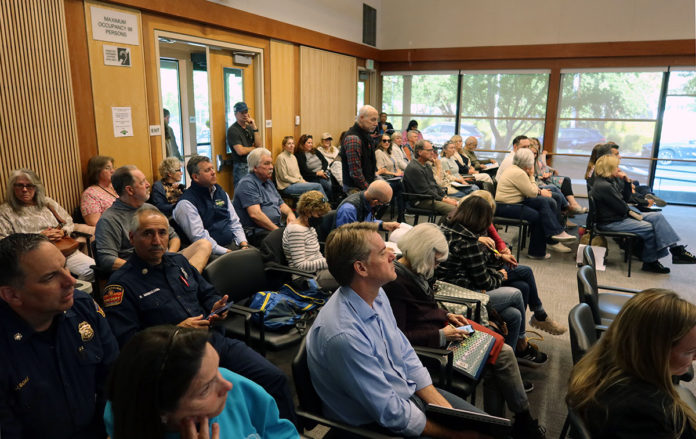
The Healdsburg City Council was faced with several challenging issues at their Monday, May 6 meeting, yet their votes did little to quash the controversies they addressed.
A public hearing on a series of proposed water and wastewater rate hikes was expected to produce outrage and objections from residents and rate-payers, but a groundswell of opposition did not materialize. Only about half a dozen people offered their public comments. And while most were opposed to the rate hikes, there were no viable alternatives presented.
But a discussion on a proposed November ballot initiative to revise the Growth Management Ordinance (GMO) also generated much debate, both from public comment and on the council itself. The council’s decision to back a Geographic Area plan over a Multifamily Rental option was not unanimous, and several area housing advocates were left dissatisfied. (See Letters in this issue.)
The water and wastewater rate hikes, which had been discussed several times previously, have become necessary to fund several crucial deferred maintenance projects, according to Utilities Director Terry Crowley. These include the 50-year-old pipe system beneath most of the city’s streets, improved filtration systems to bring water quality up to current legal requirements and rehabilitation of “lift stations” in the wastewater system.
The financial analysis was provided by Raftelis Financial Consultants, Inc., which produced the updated financial outlook and rate proposals. Early in his presentation, Kevin Kostiuk of Raftelis outlined the average monthly impact for the first year of five annual utility rate increases, which would be $16.59 more for water service, $17.62 for wastewater service. The increases would help fund $13.9 million in needed capital projects, although a significant number of capital projects are left on the table for another time or alternate funding.
In general terms, the new rate structure imposes “tiers” that base pricing on water use, with the idea that most families in the “single family residence” category will pay the lower rates, while commercial, industrial and agricultural users (categorized as “landscape” in the rates) will pay more per water unit (HCF, or hundred cubic feet) than residents do.
Tiered water charges have come under scrutiny in recent years as being in possible violation of Proposition 218, which holds that water rates must reflect the actual cost of service, and not be arbitrarily applied even if its goal is to incentivize lower water use by charging less.
Crowley addressed this issue in correspondence with the Tribune, saying the tiered fees are linked to the costs necessary to serve residential homes with higher water demands. “In providing these larger volumes of water, the City must build and maintain larger underground pipes, storage, and pumping capacities to serve the larger demands,” wrote Crowley.
Water Security
Another factor in the rate studies is a continued reliable source of water for Healdsburg customers. The current rates are based on water allocated from Russian River flows, in addition to local wells. But the river flows are expected to be reduced when the Potter Valley project is decommissioned or dismantled, as is already underway.
Potter Valley is a water diversion facility that takes water from the Eel River, directs it through a hydroelectric facility and diverts it to Lake Mendocino. The lake serves as a source for the Russian River into Sonoma County; with less water available from Lake Mendocino, annual flows down the Russian are expected to decrease.
As a consequence, Healdsburg needs to find an alternative water source in the near future. Crowley and Raftelis are proposing accessing water from Lake Sonoma previously unavailable for city use through new wells in the Dry Creek Valley.
There is currently a Dry Creek well field, in addition to two along the Russian River. One of these, the Fitch well field, will be discontinued due to rising costs. According to the Raftelis report, “The plan further prioritizes the infrastructure rehabilitation and water treatment at the Dry Creek well field while deferring the water treatment of the Fitch well field.”
A significant investment in the Dry Creek well field of almost $1.5 million is itemized in the 2029 fiscal year budget. Long range planning for investments such as this are factored into the rising annual water and wastewater rates presented to the council, which were approved on Monday for the FY 2024-25 budget.
The water and wastewater rates were presented to the council as a “public review” step required by law. Plus the law stipulates that if there are protests to the rate increases filed by half of the rate customers, the increases cannot go into effect.
At the conclusion of the public hearing, however, only 714 protests to the rate increases had been filed, far short of the 50% necessary.
The council’s vote to approve was their “approval on first reading,” which means the rate increases will next appear in the Consent Calendar at the May 20 meeting. That should put them on schedule to go into effect with the July 1, 2024 budget. Customers will see the rate increases with their August bill.
The topics of water rates and growth management are complex, and residents are encouraged to review the complete documentation on the city’s website, at Healdsburg.gov.








